The employee experience (or EX) you deliver has a direct impact on your company’s success.
Most businesses develop a solid strategy to attract top talent but some of them don’t have a concrete employee retention strategy in place while it all starts with employee experience.
💡Download our free eBook “#NoSearching Revolution” where we share tips and best practices for improving employee experience in the workplace.
Companies that are able to offer a great employee experience are the ones that successfully attract, retain, and engage the best talent.
According to Gallup, “employees have become consumers of the workplace”.
As you would put effort into creating a great customer experience, you need to craft a solid strategy to improve the employee experience you’re delivering.

Creating a winning employee experience doesn’t mean offering competitive salaries and decent benefits.
You can’t just add a few gifts to your employee compensation package or throw in some perks and consider your EX optimization efforts to be done.
Crafting a great employee experience calls for involvement across your entire company.
Before going through the tactics you can implement to improve the employee experience you’re delivering at your company, let’s get a better understanding of the key elements that shape a great employee experience.
What Is Employee Experience?
There’s some confusion around employee experience: EX is not a synonym for employee motivation, employee satisfaction or employee engagement.
However, all these three elements are connected:
- Employee satisfaction has a direct impact on employee experience
- Employee motivation is a result of employee experience
- Employee experience has a great impact on employee engagement
So, What Does Employee Experience Mean?
In a nutshell, employee experience includes all the observations, perceptions and feelings employees have about their role in the company and the company itself: its vision, values and goals.
The way employees feel about the company and their role has a great and direct impact on their morale, productivity and engagement.
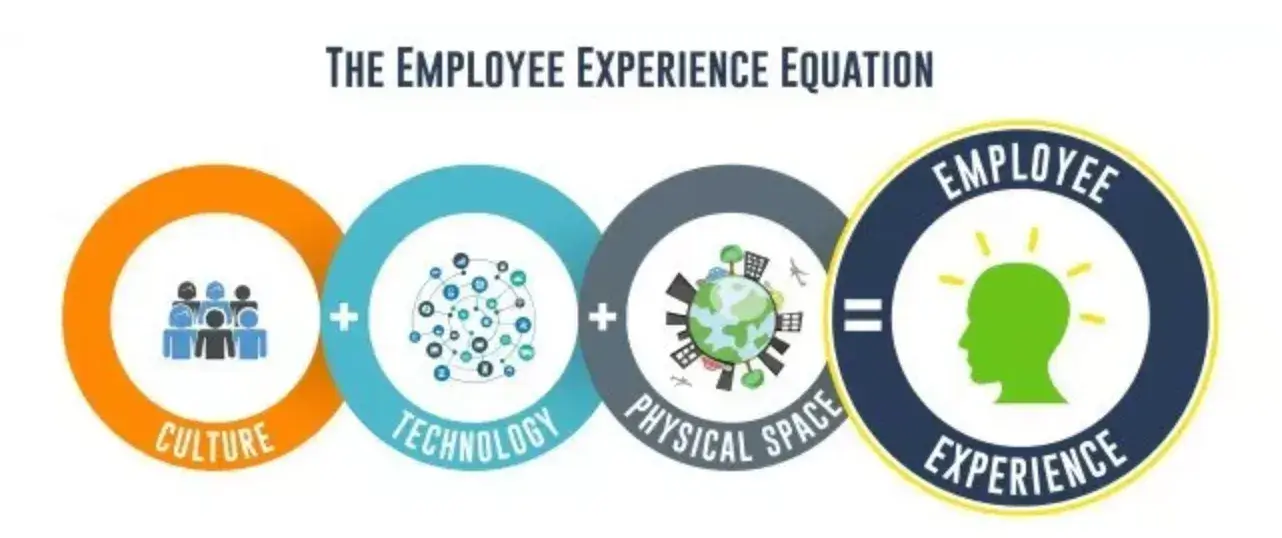
Source: Jacob Morgan Inc
When it comes to employee retention, it all starts with the employee experience you deliver. But the employee experience you craft also has a great impact on your talent attraction strategy.
Related: 3 Reasons Why Employee Experience Should Be Your Number One Priority
In other words, if you want to attract and retain top talent, make sure you deliver a great employee experience!
Employee Experience Through the Employee Lifecycle
The way employees feel about the company, the team and their role throughout their journey in the company will impact the overall employee experience.
If you want to create a winning employee experience, you’ll need to consider the employee life cycle and find ways to improve the employee experience you deliver in each of the six stages of the employee life cycle: talent attraction, recruitment, onboarding, career development, retention and separation/offboarding.
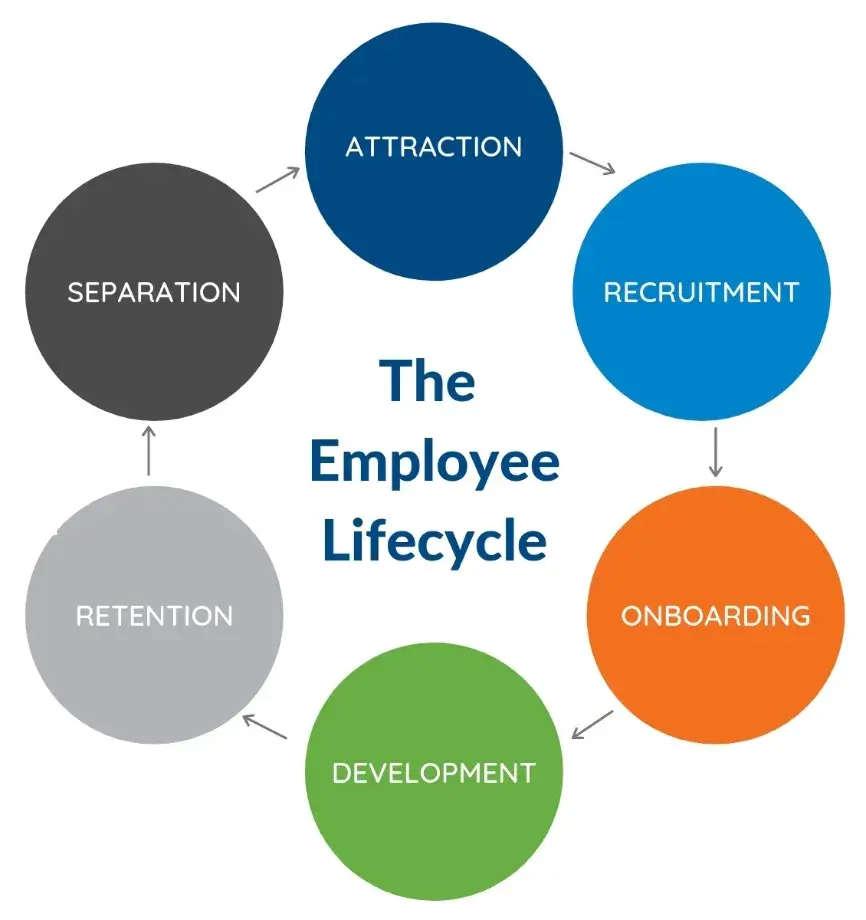
Source: CCI Consulting
Put simply, the employee experience already start in the talent attraction and recruitment stages.
The way you communicate the company culture but also the discussion the recruiting team has with candidates already impact how they feel about the company once they join your team.
Related: Top 15 Employee Motivation Tips and Benefits
The onboarding process, working conditions, workplace, company culture and career development opportunities will have a direct impact on the employees’ satisfaction and their motivation to stay with the company.
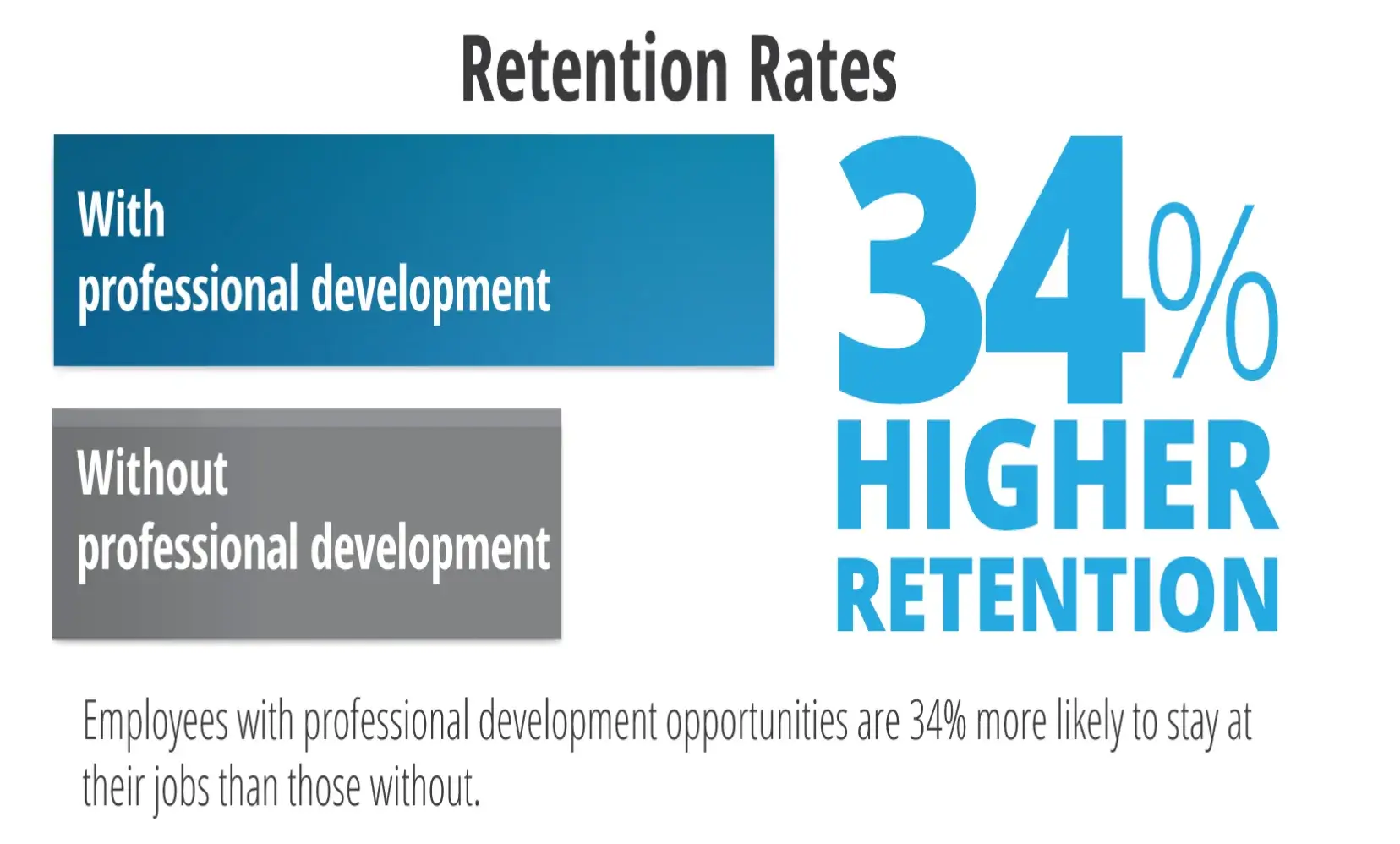
Source: BetterBuys
Even though many businesses don’t include the offboarding stage into their employee retention strategy, this stage is as important as the other ones when it comes to employee experience.
The conditions in which ones an employee leaves the company has a tremendous impact on the employee experience.
And remember, your employees can still be great brand ambassadors after leaving the company if they are happy with the offboarding process.
How to Create a Winning Employee Experience at Your Company?
1. Rethink Your Internal Communication
An effective internal communication, which involves making sure that employees have easy access to the right information and resources when they need them, is the cornerstone of employee experience.
Related: Improving Employee Engagement With Internal Communications
Think about it: the average worker spends 2.5 hours a day looking for information required to complete tasks.
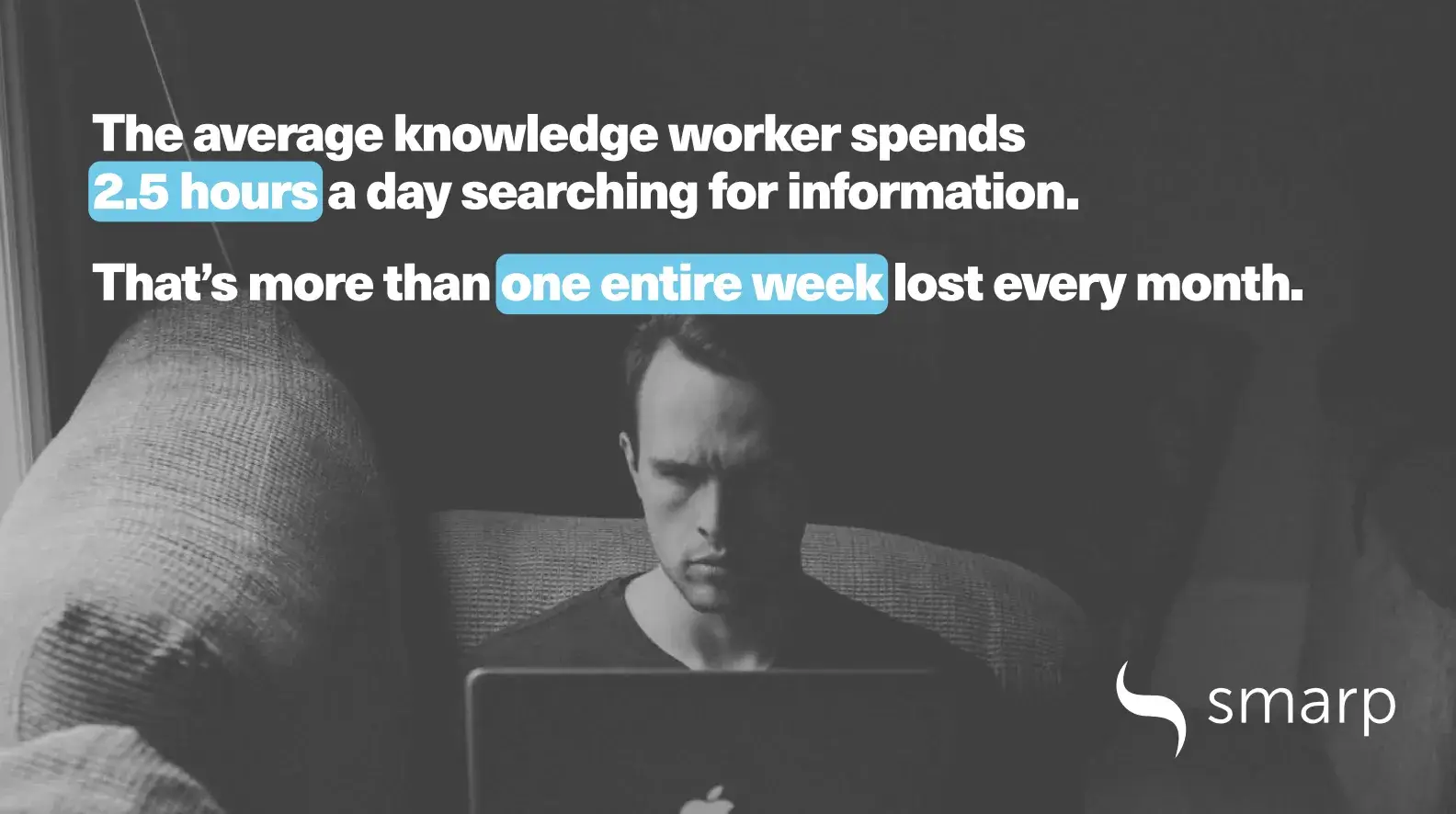
What’s more, some businesses are still using outdated intranets to develop their internal communication. When information doesn’t flow, employee frustration rises!
The Content Marketing Institute found that 42% of companies don’t have the right technology to manage content across their organizations.
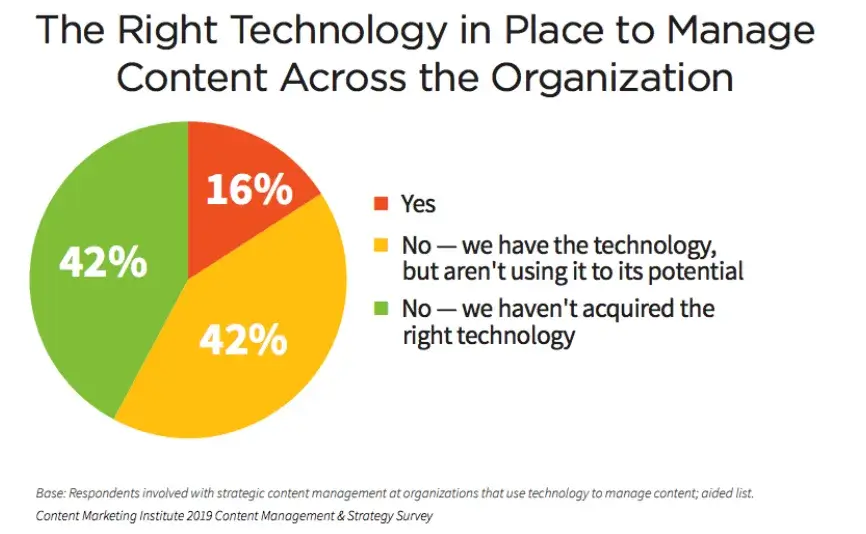
Source: Content Marketing Institute
Your aim is to use internal communication technology to improve communication throughout your company.
With efficient internal communications, your employees can see how their efforts contribute to the company’s success, raising their feeling that they are involved in meaningful work.
Related: Andrew Spence on Helping Employees Find Meaning at Work
Establishing good internal communications begins on day one. Your recruitment and onboarding process sets the stage for employees to expect and deliver good communication.
Remember that your communication should be a two-way dialogue: give your employees a say and encourage them to actively contribute to your internal communication strategy through content creation and content sharing.
Related: 5 Ways to Truly Connect with Your Employees
2. Encourage Professional Development
Employees who don’t feel encouraged to acquire new skills won’t feel engaged.
Randstad US conducted a research to understand the reasons why people decided to quit their job. They found that:
- 58 percent of the surveyed workers decided to quit their job because they didn’t find enough growth opportunities to stay longer with the company.
- 57 percent of respondents said they needed to leave their current companies to take their careers to the next level.
- 69 percent said they would be more satisfied if their employers better utilized their skills and abilities.
When employees feel that their organization cares about them and their professional career, they enjoy a much better employee experience which improves employee retention rates.
So, if you want to truly support your employees’ professional growth, you’ll need to make it one of your top priorities.
One of the best ways to help your employees acquire new skills is to craft a solid employee development program that you integrate into your employee value proposition (or EVP).
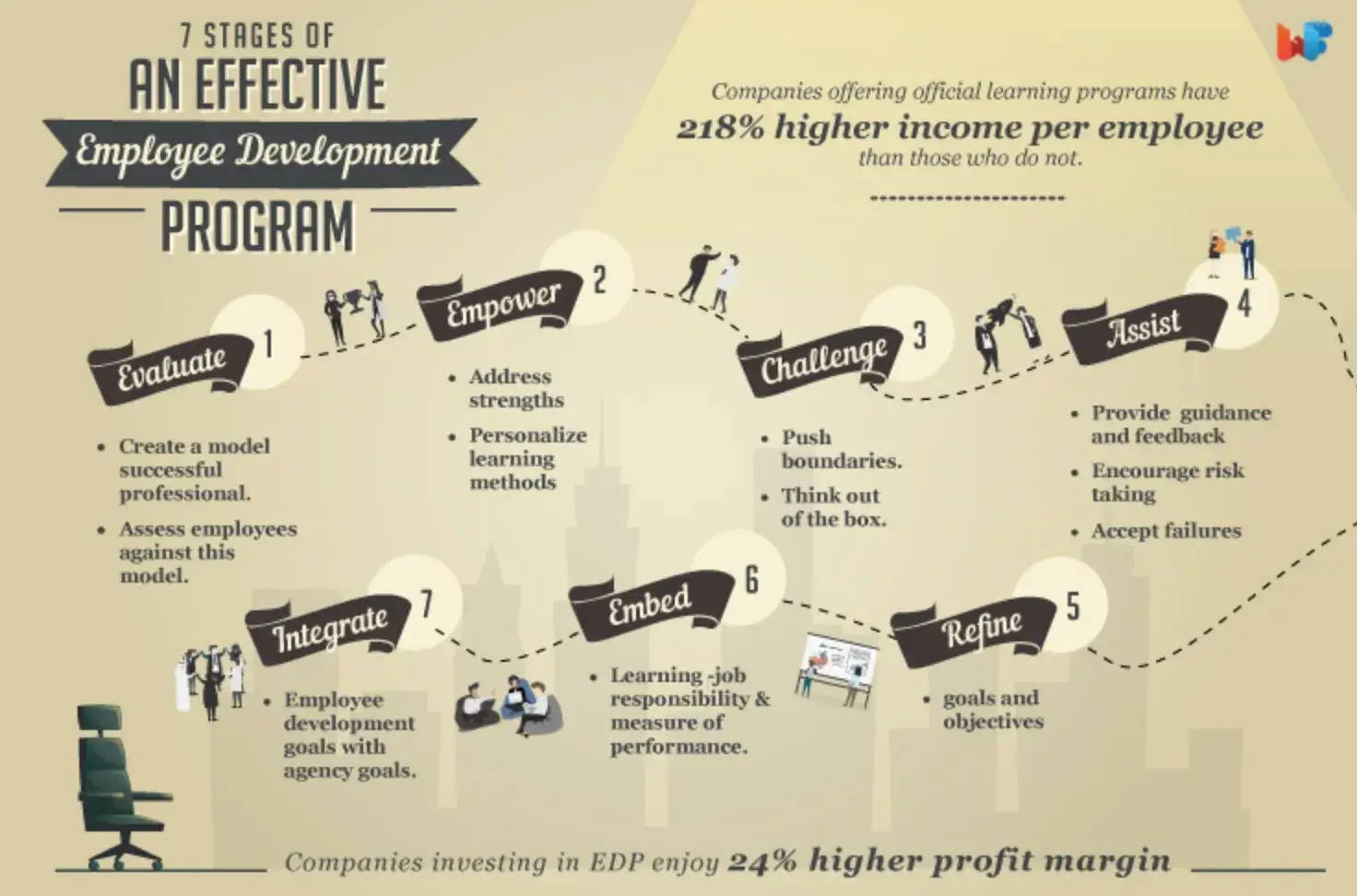
Source: 7 Stages Of An Effective Employee Development Program [Infographic]
You’ll need to customize the program that you offer for each of your employees based on their expertise and the skills they want to acquire.
Set one-on-one sessions with your employees to get a better understanding of their mid-term and long-term professional goals.
These one-on-one sessions are also a great way to decide together with the employees on the training programs they’ll attend based on their professional goals.
Keep in mind that investing in your employees’ professional growth is a win-win situation:
- Your employees acquire new skills and take their career to the next level.
- You improve workplace productivity and grow your business: companies that provide their employees with learning programs have 218 percent higher income per employee than those that don’t have this kind of program in place.
3. Implement an Employee Wellness Program
Yes, your employees’ wellness matters! Remember what Sir Richard Branson, founder of the Virgin Group declared about the importance of taking care of your employees: “Train people well enough so they can leave, treat them well enough so they don’t want to”.

Source: secretstotheirsuccess.com
It’s important to make your employees’ health one of your top priorities. The strategy you’ll craft to improve your employees’ well-being will depend on your company culture.
You can for example:
- Encourage your employees to practice a sport (and to stick to it!)
- Organize off-site activities where they can have some fun together
- Organize weekly yoga or meditation sessions
- Allow your employees to work remotely once in a while
- Organize a talent show on a monthly basis (it’s a great way to have fun!)
- Celebrate the Employee Appreciation Day
- Organize brainstorming sessions where employees can share ideas (it’s also one of the best ways to enhance creativity!)
- Encourage your employees
- Acknowledge their efforts and achievements
- Show empathy: 96 percent of employees believe showing empathy is an important way to improve employee retention

In a nutshell, showing understanding, flexibility and concrete support breeds employee loyalty and maintains employee productivity in the long term, and your team will appreciate it.
Related: Empathy in the Workplace: Top Reasons Why You Need to Develop It
4. Build a Positive Company Culture
Company culture is key to creating a winning employee experience in the workplace.
Your company values will have a great impact on your work environment and ultimately on how your employees feel about your brand.
Make sure you develop a company culture that inspires your employees and enhances creativity, professional development, and employee wellness as explained earlier.
Related: Building a Company Culture that Drives Employee Engagement
In the video below, Chris White, former Director of the Center for Positive Organizations at the University of Michigan, shares his best practices for creating a great company culture:
Keep in mind that creating a positive working environment also means making sure that employees are and feel safe at work.
A great workplace goes beyond the furniture, office decor, or whether your workplace is an open space or not.
The Workplace Bullying Institute found that 60.3 million Americans had been bullied at work, and that only 29% received an adequate response from their employer. Make sure you create a safe workplace with zero tolerance for any kind of office bullying.
5. Ask for Feedback
Even though employee feedback is key to building a successful business, most companies skip this step.
How can you improve your workplace if you don’t ask for or listen to your employees’ opinions?
Your employees can provide you with valuable feedback that will help you improve the workplace but also your product.
Don’t forget that feedback in the workplace goes both ways: ask your employees for suggestions to improve the workplace and provide them with feedback on their work and commitment as well. It’s a great way to help them improve their work habits and performance.
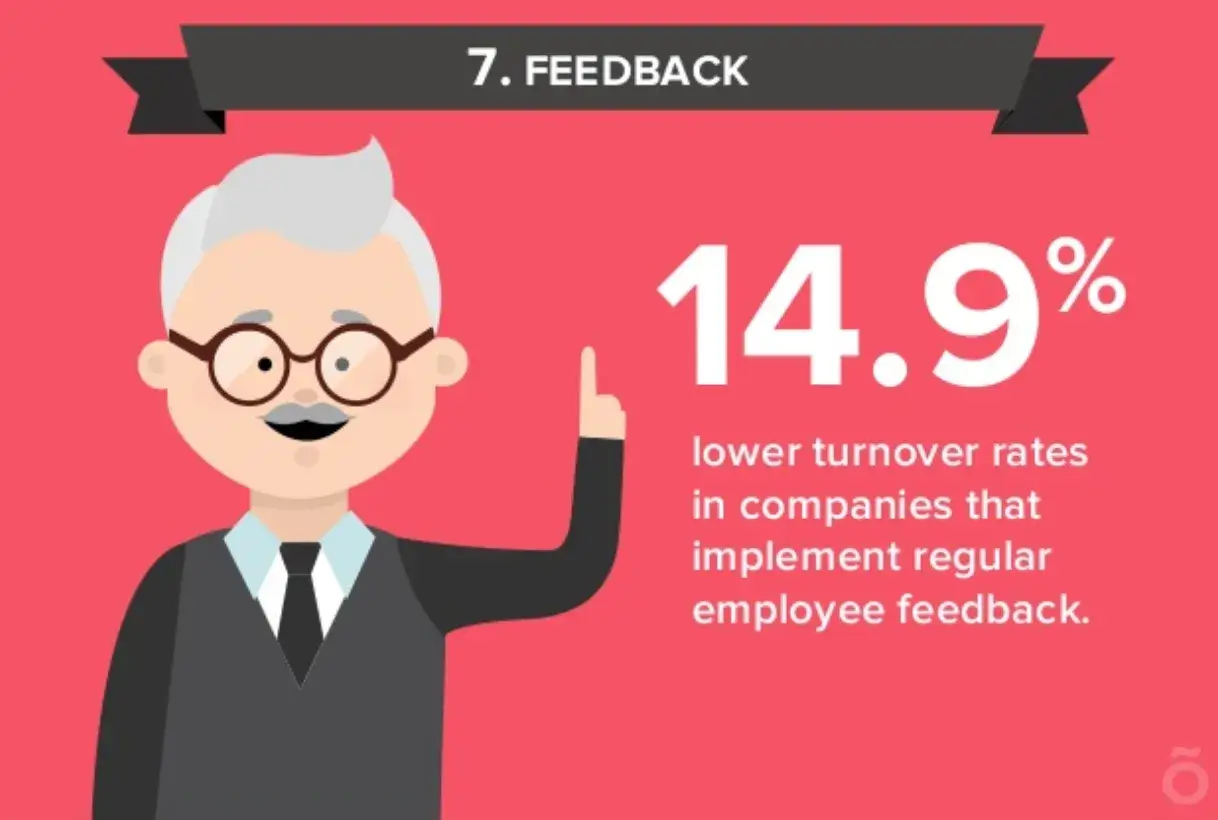
Source: Officevibe
Think about it: 35 percent of employees working at companies that don’t provide feedback feel happy at work while 51 percent of employees report being happy at work after receiving regular feedback and recognition.
What’s more, companies that provide employees with feedback have 14.9 percent lower turnover rates.
Key Takeaways
There are no quick fixes to improve your employee experience. Creating a great EX is a total commitment. Because it includes every aspect of your business, you need to look at every employee life cycle stage to craft a winning employee experience.
It begins with the discussions your recruiting team has with candidates, and it continues with your onboarding process and the professional development opportunities you create for your employees. Don’t forget that the offboarding process will also impact the employee experience and your ex-employees’ willingness to advocate for your brand!









